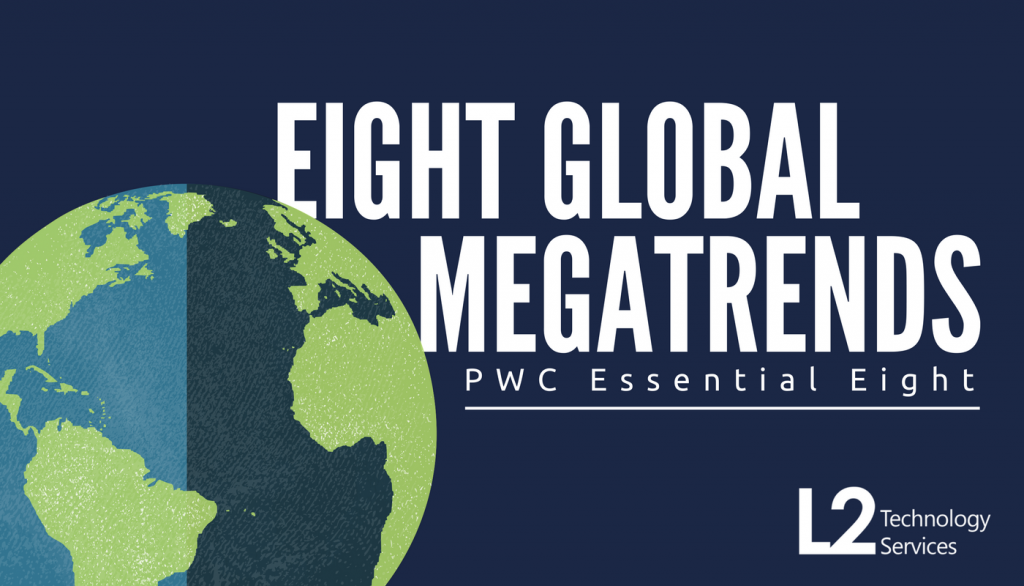Over 150 technologies were considered as part of the PWC Essential Eight Global Megatrends review where technologies with the greatest expected impact over the next 5 to 7 years are identified. Only eight technologies made the list and our review of the technology and example use cases follows.
1. Artificial Intelligence
Using computer systems and technology to perform activities that would otherwise require human intelligence. While many people immediately think of futuristic movies with lifelike robots that can interact on a human level, this technology is available today and being used in ways that allow humans to focus on more challenging problems. Forms of artificial intelligence have been around since the 1950’s and became popular with large tech companies during the 90’s and 00’s. Companies like Google have leveraged the power of artificial intelligence in the form of machine learning to power smart search engines, powerful mail filters, and even automated assistants.
Use Cases:
- Predictive Maintenance
- Natural Language Processing
- Security
- Recommendations
- Anomaly Detection
2. Augmented Reality (AR)
The combination digital information with reality – typically by layering data, imagery, audio, or haptic feedback onto the real world via a computer device. If you’ve ever watched Monday Night Football, you’ve likely seen the yellow first down line digitally overlaid onto the field – this is a form of augmented reality. One of the more common use cases of Augmented Reality is to combine digital information or imagery overlaid on top of the real world – either through glasses or a device with a camera. Common examples of AR include Microsoft Hololens, Google Glass.
Use Cases:
- Technical Analysis
- Maintenance
- Training
- Marketing
- Product Design
3. Blockchain
A distributed, immutable digital ledger of data records. While blockhain technology has historically most often been associated with Bitcoin – a digital currency – it’s now being used on many other areas including IoT, healthcare, and big data. And if a digital ledger sounds a lot like a database, that’s because blockchain is a lot like database. Some of the key features of the blockchain are it’s distributed nature and immutability. A blockchain is run by many different servers instead of a centralized set of servers and once data is entered into the system the data can’t be directly overwritten. In order to change data, an additional entry has to be made, much like an accounting ledger, and all of the history remains providing traceability.
Use Cases:
- Internet of Things
- Big Data
- Distributed Databases
- Financial Sector
- Healthcare Sector
4. Drones
Formally known as Unmanned Aerial Vehicles (UAVs), drones are aircraft which are piloted remotely or by onboard computers. Drones are beginning to enter mainstream as both recreational items for consumers as well as powerful tools for businesses. Companies like UPS and Amazon are working to figure out how drones can be used for fast and cost-efficient package delivery while farmers and industrial companies are leveraging drones to remote inspect and surveil areas that could previously only be reached using high cost and high risk methods.
Use Cases:
- Package Delivery
- Facilities Inspection
- Wind Turbine Inspection
- Surveillance
5. Internet of Things (IoT)
The network of interconnected physical devices embedded with sensors and technology enabling the sending and receiving of data. And while the topic has the word Internet in the title, the key focus is on connecting physical devices to a network to be able to send and receive data. This network can be a private network within an Enterprise or connectivity over the public Internet – typically via secure tunnels or encrypted channels. Many organizations are changing their service organizations over to Connected Services – wherein they are leveraging the power of IoT to enable new service models and new methods of delivering value to their customers and shareholders. Some products have sensors that are lying dormant or only used intrinsically within the product and these sensors can be connected to the network unlocking new insights and business models. In many cases, products are being Smart Enabled either from the factory or by using aftermarket wired and wireless sensor technologies.
Use Cases:
- Remote Monitoring
- Predictive Maintenance
- New Business Models
- Warranty Mitigation
- Customer Intimacy
6. Robots
Mechanized machines capable of carrying out procedures automatically or via programming. While the manufacturing space has been leveraging robots for decades, other industries are beginning to realize how robots can be used to automate redundant simple tasks as well as highly complex tasks that require a high degree of precision. Amazon purchased robotics company Kiva Systems in 2012 and doubled the amount of robots being used in their warehouses between 2014 and 2015. Worldwide, the growth of robotics in the industrial space has continued to increase at a rapid pace growing from 60k industrial robots shipped in 2009 to 239k shipped in 2015.
Use Cases:
- Manufacturing
- Agriculture
- Safety / Military
- Hazardous Area Inspection
7. Virtual Reality (VR)
Fully immersive digital environment generated using computer graphics and audio. Like Augmented Reality mentioned above, Virtual Reality uses computer graphics and digital capabilities – the difference is that with VR, the user is fully enveloped in the virtual world rather than having digital imagery overlaid on top of the physical world. Common examples of Virtual Reality include Google Cardboard, Samsung Gear VR, Oculus Rift, and HTC Vive – these headsets allow the wearer to be immersed in the digital experience and as they move their head to look around they are able to look around and interact with the virtual world. Organizations like Flowserve, a large industrial manufacturer, are leveraging virtual reality to create game like applications to train employees and customers using the real controls they would use on expensive industrial equipment. This allows them to simulate costly failures and upset conditions without experiencing the real cost of the failure.
Use Cases:
- Training
- Simulations
- Product Design
- Virtual Tours
8. 3D Printing
Creating a physical object from a digital model – typically by laying down multiple layers of a material in succession. Also known as additive manufacturing in the industrial space, 3D printing creates physical objects by adding material (often starting from nothing) rather than starting with a block of material and removing material to create the end product. The technology has evolved from printing small plastic objects to being able to print materials of all types including metal and high strength / high temperature materials that can be used in tough industrial environments. Companies like Nike are using 3D Printing to quickly move from idea, to prototype, to working product – they can print a 3D mockup of a design in a few hours which allows them to get hands on with a product to understand how it feels in the real world and what changes might need to be made.
Use Cases:
- Product Design
- Prototyping
- Parts Manufacturing
- Rapid Manufacturing
- Reverse Engineering


Very exciting stuff. Please continue to share your observations and analysis.
Thanks for the comment, Gail! I’m glad you enjoyed the article and stay tuned as we have a series of articles planned.
Great stuff. Thx for sharing!!
Glad you liked it! Thanks for commenting!
Great summary of upcoming near future. I especially state that ‘near future’ because of the fact that all these innovations are being realized quite faster than ever.
Thanks…
Erkut
Erkut-
It is an amazing time we live in and exciting to see companies gaining a competitive edge by leveraging some of these technologies. It’s even more exciting for L2 to be a part of helping organizations unlock hidden value by leveraging these technologies.
Nice résumé. Some use cases are already present
It is exciting to see how many of these technologies are already available and already being implemented!
Great summary of these key technologies.
I particularly liked your explanation of Blockchain – I had trouble with it before.
An example of each of your use cases, with links would be a fantastic additional resource, e.g. for start-ups, students and even established organisations!
The technologies seem to be racing ahead faster than we are able to apply them!
Thanks for the feedback, Andy! Glad to hear that the blockchain explanation was helpful. We’ll make sure we include more examples in future articles as we plan to do dedicated articles for many of these technologies.
Josh, What stands out for me is AI. Recent work has it making predictions about autism within the first 12 months of a baby’s life. What an exciting advance! Also, thanks for making the distinction between Virtual Reality and Augmented Reality; too many people gloss over that.
The progress in AI is exciting! Combining technologies from this list makes things really interesting. For example, it’s awesome to see what’s possible when data from IoT is paired with the analytics capability of AI.
A good summary Josh, sharing this now with my contacts.
Thanks for reading – I hope your contacts enjoy as well!
Great Summary Josh. Industry examples where some combinations of these technologies have been applied with acceptable ROI would be helpful !
Thanks for the feedback, Jayan! We will keep your feedback around including industry examples in mind as we post more articles!